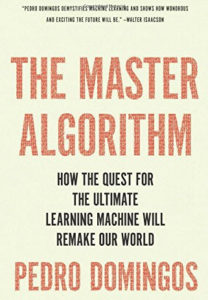 The Master Algorithm by Pedro Domingos [1] is easily misjudged. The book is not an introductory text in data science since beginners will not be able to follow the author’s reasoning. Further, the book is also not for the faint hearted or the weak minded in data science. However, savvy professionals and open-minded researchers should take note. There are many provocative ideas that could be foundational to future machine learning systems.
The Master Algorithm by Pedro Domingos [1] is easily misjudged. The book is not an introductory text in data science since beginners will not be able to follow the author’s reasoning. Further, the book is also not for the faint hearted or the weak minded in data science. However, savvy professionals and open-minded researchers should take note. There are many provocative ideas that could be foundational to future machine learning systems.
The book is written in a casual eclectic style, drawing examples from diverse sources. Be prepared for a delightful romp through the theory and folklore of analytics, accompanied by a disorienting rearrangement of what you know about data analysis. If you persist to book’s end, you will sense much about the personality of the author. For me, having a few beers with the author would be a kick!
The focus is not about analytics per se, but big learning that uses big data for big problems. Domingos challenges all of us to a lofty goal – create the ultimate learning algorithm that will deduce the mechanism for an apple falling from a tree and enable your future car to do all the driving for you. This challenge is much more than generalizing beyond known data or incrementally refining results of that generalization. It is about combining different learning approaches to discover optimal solution procedures. The difference is like creating an algorithm that catches a fish versus an algorithm that learns how to catch fish. The aha chapter for me is Learning Without a Teacher, which discusses research about how infants learn the basics of physical reality in their first few weeks. So, create an algorithm that will learn how to move your arms to touch your nose.
Domingos asserts that approaches to learning algorithms have evolved (somewhat independently) from five tribes (cultures or flavors) of analytics – evolutionaries (genetic algorithms), connectionists (neural networks), symbolists (decision trees), Bayesians (naïve Bayes), and analogizers (support vector machines). In general, this distinction makes sense, although the boundaries are often murky. Half the book (chapters 3-7) describes the five tribes, which is nicely summarized in an ACM webinar [2].
Spoiler Alert! Chapter Nine discusses how all the parts of the puzzle come together. Actually not! The chapter is more of a tease to get us to think about creating this master algorithm. The analogy of a city with sectors for each of tribe is a glorious attempt at visualizing the workings of this algorithm. Someone must do a YouTube video! Also, Domingos makes a plea for his research on Markov Logic Networks [3] as the unifying concept and mechanism for bringing all the tribes together. Note to self: study MLN!
It would be fascinating to use this book for a doctoral-level seminar on data science. Assign the students randomly to one of the five tribes. Then, let them argue (and demonstrate) about how their tribe would solve specific problems. Domingos’ thesis would be substantiated if, after frustrating weeks, the tribes started to collaborate. Students may require emotional assistance toward the end of the seminar.
Relevance to Immersive Analytics
Data worlds may be the only sufficiently robust environment to support human interaction with a potential master learning algorithm. If human judgment is to play a nontrivial role in machine-augmented decision-making, the human interface must be a collaborative multi-person environment. Key aspects of analytical processes can be sensed as behaviors within the data world, which is referred to as “turning analytics inside-out” [4]. Domingos argues that a master learning algorithm could result in “asymptotical growth to a perfect understanding of the real world.” If true, ethical issues arise about how to turn such algorithms inside-out to enable the understanding and governance of their functioning.
The IA community needs to build data worlds that exhibit the desired qualities of inside-out analytics and collaborative human-machine learning. To progress, we need to experience both the good and bad of such qualities. In his last chapter, Domingos paints a positive prediction for healthy human-machine collaboration, in which the machine does not mimic some scary sci-fi movie.
References
[1] Pedro Domingos, The Master Algorithm: How the Quest for the Ultimate Learning Machine Will Remake Our World, Basic Books, ISBN-10: 0465065708, September 22, 2015. [amazon] TIP: scan the 60+ customer reviews for a diversity of perspectives on Domingos’ book.
[2] Pedro Domingos, Five Tribes of Machine Learning (And What You Can Learn from Each), ACM Webinar, November 14, 2015. [62-min video, pdf slides]
[3] Wikipedia, Markov logic network, Retrieved 18:02, May 6, 2016. [link] Note the PDF paper by Richardson & Domingos in 2006. Also a search of Google Scholar will list many current MLN research papers.
[4] Richard Hackathorn & Todd Margolis, Immersive Analytics: Building Virtual Data Worlds for Collaborative Decision Support, IEEE VR2016 Workshop on Immersive Analytics, March 20, 2016. [pdf]
